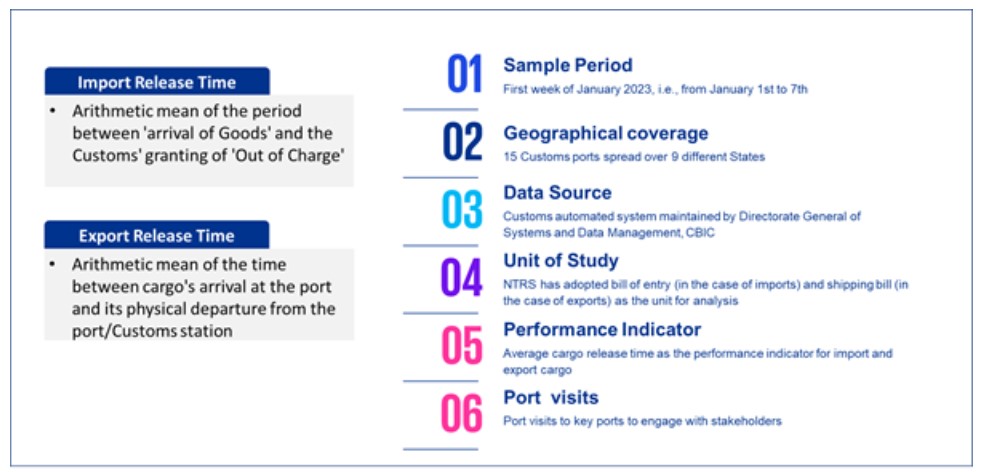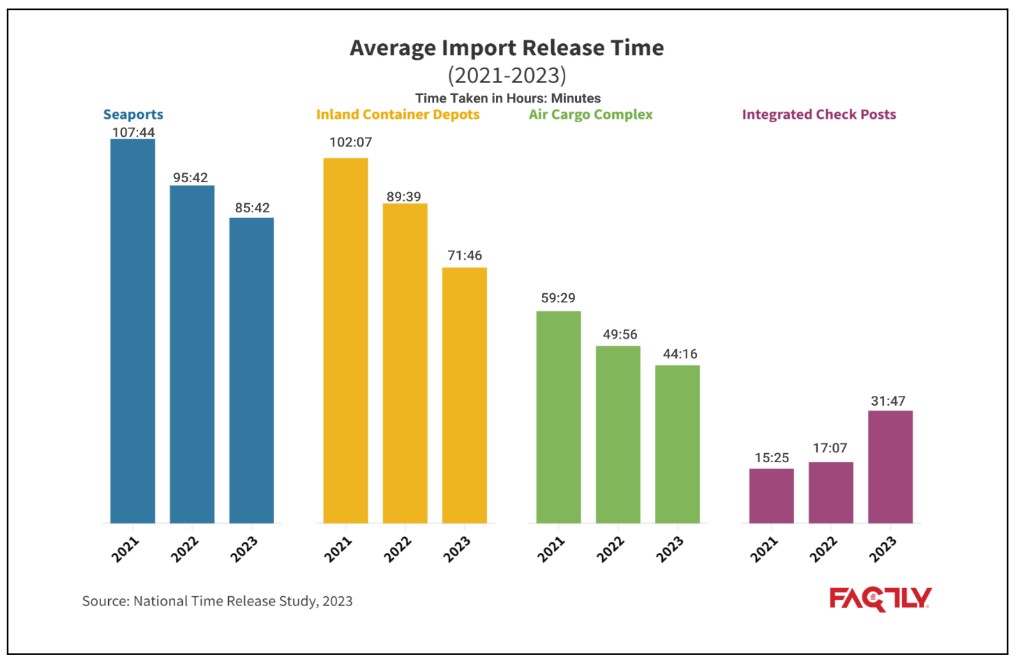The government recently released the NTRS 2023 that presents the findings of the annual study of cargo clearance process through four categories of ports, namely seaport, inland container depot, air cargo complexes, and integrated check posts on land borders for both import and export cargo. Here is a review.
Release of goods is a critical step in the clearance process undertaken by customs authorities. It involves the coordination among multiple agencies such as the port authority, ministry of health, departments of agriculture and veterinary, national committee of standards, etc. The World Trade Organization’s Trade Facilitation Agreement contains provisions to make the movement, release and clearance of goods, including goods in transit faster. It provides for the WTO Members to measure and publish the average release times of goods at the border to provide traders with the time usually taken to release the goods. The World Customs Organization has also recommended the publication of such period study as a performance measurement tool.
National Time Release Study for 2023 was released by the CBIC
In India, the National Time Release Study (NTRS) for 2023 was recently released by the Central Board of Indirect Taxes and Customs (CBIC). The report presents the findings of the annual study of the cargo clearance process through four categories of ports, namely seaports, inland container depots (ICD), air cargo complexes (ACC) and integrated check posts (ICP) on land borders for both import and export cargo. The report for 2023 is the third in the series of NTRS adopting the standardized methodology and presents comparable intertemporal performance assessment of trade facilitation measures. Prior to this, Time Release Studies were published by individual custom houses. The first formal Time Release Study was at Jawaharlal Nehru Custom House (JNCH) in 2017 covering only import release time.
Cargo release time is defined as the time taken from the arrival of the cargo at the Customs station to its out-of-charge for domestic clearance in case of imports and arrival of the cargo at the Customs station to the eventual departure of the carrier in case of exports. Time is an important parameter for assessing a country’s Ease of Doing Business and has a huge impact on the cost of trade. The time taken for executing trade procedures should be as short as possible for seamless and efficient delivery of goods. A country’s attractiveness and competitiveness as an investment location gets affected by delays at borders in clearing cargo. The delay costs the companies both time and money.
NTRS provides inputs for decision making
Such periodic Time Release studies help countries to identify bottlenecks in cross-border trade and focus on streamlining processes to optimize efficiency. Additionally, the NTRS is a source of input to businesses and policymakers for decision-making as well as to monitor the movement towards achievement of National Trade Facilitation Action Plan (NTFAP) targets. The study also helps understand the impact of various trade facilitation initiatives, notably “Path to Promptness” and identify the challenges to more expeditious reduction in release time by carrying out in-depth analysis alongside stakeholder consultations for import and export clearance process.
Various factors affect the time taken for release such as the mode of cargo movement, facilitation time taken by the Risk Management System, and assessment of bills of entry, among others. Considering that the cargo release time is dependent on various factors and is expected to be different for export and import, the NTFAP 2020-2023 has prescribed bringing down the average cargo release time to
- Within 48 hours for Sea Cargo, Inland Container Depots, and Land Customs Stations, and 24 hours for Air Cargo for imports
- Within 24 hours for Sea Cargo, Inland Container Depots, and Land Customs Stations, and 12 hours for Air Cargo for exports
NTRS 2023 is based on the sample period of the first week of January 2023, comparing the performance with the corresponding periods of 2021 and 2022. The study covers 4 Seaports, 6 Air Cargo Complexes, 3 Inland Container Depot and 2 Integrated Check Posts which together account for nearly 80% of the bills of entry and 70% of the shipping bills filed in the country.

Average time taken for releasing imports has reduced in the last three years for Seaports, ICDs, and ACCs
The average time taken for releasing imports has reduced in the last three years for three port categories- Seaports, Inland Container Depots (ICDs), and Air Cargo Complex (ACCs). The import release time for seaports is 85 hours and 42 minutes, for ICDs is 71 hours and 46 minutes, for ACCs is 44 hours and 16 minutes, and for ICPs is 31 hours and 47 minutes. Compared to 2022, the release time has reduced by 20% for ICDs; 11% for ACCs; and 9% in 2023. Despite the reduction, the release time is much longer than the prescribed targets. In the case of Integrated Check Posts (ICPs), the average release time has doubled over the years. However, it continues to be well below the NTFAP target.

Release time for exports has also improved
Likewise, there has been an improvement in the release time for exports as well across all the port categories, as compared to 2022. The export release time for arrival to departure in absolute terms was 175 hours and 55 minutes for Seaports, 129 hours and 33 minutes for ICDs, 28 hours and 18 minutes for ACCs and 11 hours and 7 minutes for ICPs. This is far from the targets set under NTFAP.
For both imports and exports, the improvement in the average release time is accompanied by a lower standard deviation, which means that there is greater certainty of the expeditious release of imported cargo and for the departure of cargo from its arrival at the port.
The study reaffirms the significance of the ‘Path to Promptness’ strategy
With respect to imports, the study calls for a more effective Authorised Economic Operator (AEO) scheme by increasing benefits and making the process simpler. It also suggested increasing the capacity and sensitization of assessing officers to improve the release time of imports. Furthermore, it noted that there was a significant lack of awareness about various trade facilitation initiatives of the government and recommended a concerted outreach to the EXIM community. With respect to exports, the study highlights a need to start Exports Dwell Time Report (DTR) like the one on imports published by CBIC. It recommended the formulation of local initiatives to streamline the cargo clearance process.
The study also captures India’s progress towards the three-fold ‘Path to Promptness’ strategy for import release time which is based on the filing of advance bills of entry, allowing for pre-arrival processing, enhanced levels of facilitation, promotion of Authorised Economic Operator (AEO) scheme and increased utilization of Direct Port Delivery (DPD) scheme.


